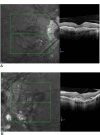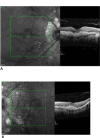Choroidal neovascularization secondary to angioid streaks in a patient with pseudoxanthoma elasticum: case report
- PMID: 39936052
- PMCID: PMC11809835
- DOI: 10.22336/rjo.2024.85
Choroidal neovascularization secondary to angioid streaks in a patient with pseudoxanthoma elasticum: case report
Abstract
Objective: Present the diagnosis and therapeutic approach in a patient with pseudoxanthoma elasticum and ocular involvement.
Case report: A 46-year-old patient presented for progressive loss of vision and metamorphopsias in the left eye. The ophthalmological examination showed angioid streaks and secondary choroidal neovascularization. The dermatologist performed an incisional biopsy of a skin area in the right axilla that showed white-yellow, discrete streaks. Histopathological examination confirmed the diagnosis of pseudoxanthoma elasticum. It was decided to start intravitreal injections with aflibercept. Three injections were made in the left eye with subsequent visual acuity improvement.
Discussion: Angioid streaks are a rare retinal condition, and pseudoxanthoma elasticum is the most common association. Other systemic conditions are Ehlers-Danlos syndrome, Paget's disease, and hemoglobinopathies. Definite diagnosis requires skin lesions or calcified elastic fibers on pathological examination and angioid streaks of the retina. Choroidal neovascularization is a frequent complication and leads to vision loss. Intravitreal inhibitors of vascular endothelial growth factor are currently the first line of treatment.
Conclusions: Pseudoxanthoma elasticum has numerous systemic manifestations and requires a multidisciplinary team to be monitored and treated.
Keywords: ABC = ATP-binding cassette; AS = Angioid streaks; ATP = adenosine triphosphate; Anti-VEGF = Anti-vascular endothelial growth factors; BE = Both eyes; CNV = Choroidal neovascularization; CRT = Central retinal thickness; FA = Fluorescein angiography; FAF = Fundus autofluorescence; IOP = Intraocular pressure; LE = Left eye; NCT = Non-contact tonometer; PPi = Inorganic plasma pyrophosphate; PXE = Pseudoxanthoma elasticum; RE = Right eye; RPE = Retinal pigment epithelium; SD-OCT = Spectral-domain optical coherence tomography; angioid streaks; choroidal neovascularization; pseudoxanthoma elasticum.
© 2024 The Authors.
Conflict of interest statement
The authors state no conflict of interest.
Figures




References
-
- Stumpf MJ, Mahn T, Steinmetz M, Fimmers R, Pizarro C, Nickenig G, Skowasch D, Schahab N, Schaefer CA. Pseudoxanthoma elasticum-also a microvascular disease. Vasa. 2020 Jan;49(1):57–62. doi: 10.1024/0301-1526/a000811. Epub 2019 Jul 31 https://econtent.hogrefe.com/doi/10.1024/0301-1526/a000811?url_ver=Z39.8.... - DOI - DOI - PubMed
-
- Harmsen IM, Kok M, Bartstra JW, de Jong PA, Spiering W, Foppen W. Do pseudoxanthoma elasticum patients have higher prevalence of kidney stones on computed tomography compared to hospital controls? Clin Exp Nephrol. 2024 Jan;28(1):75–79. doi: 10.1007/s10157-023-02405-2. https://www.ncbi.nlm.nih.gov/pmc/articles/PMC10766656/ Epub 2023 Oct 14. - DOI - PMC - PubMed
-
- Iwanaga A, Utani A, Koike Y, Okubo Y, Kuwatsuka Y, Endo Y, Tanizaki H, Wataya-Kaneda M, Hatamochi A, Minaga K, Ogi T, Yamamoto Y, Ikeda S, Tsuiki E, Tamura H, Maemura K, Kitaoka T, Murota H. Clinical practice guidelines for pseudoxanthoma elasticum 2017 Clinical Practice Guidelines for Pseudoxanthoma Elasticum Drafting Committee. J Dermatol. 2022 Mar;49(3):e91–e98. doi: 10.1111/1346-8138.16301. Epub 2022 Jan 12. https://onlinelibrary.wiley.com/doi/10.1111/1346-8138.16301. - DOI - DOI - PubMed
-
- Mandura RA, Radi RE. Angioid Streaks in Pseudoxanthoma Elasticum. Cureus. 2021 Jun 17;13(6):e15720. doi: 10.7759/cureus.15720. https://www.ncbi.nlm.nih.gov/pmc/articles/PMC8286068/ - DOI - PMC - PubMed
Publication types
MeSH terms
Substances
LinkOut - more resources
Full Text Sources
Research Materials
